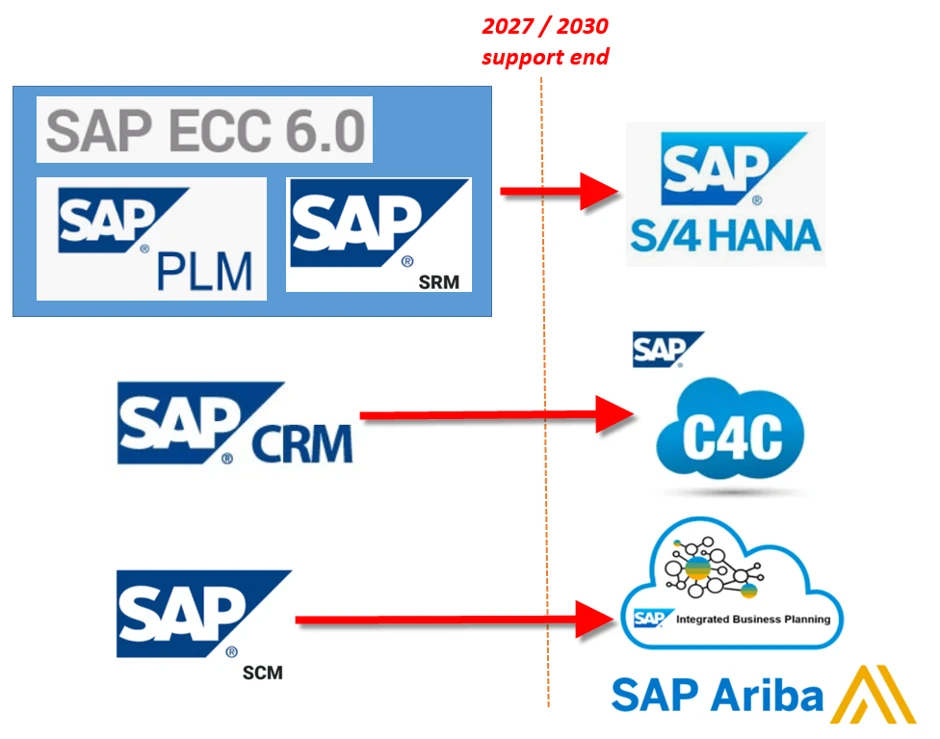SAP Extend Support for Business Suite 7 – How will this affect you? - Your Questions Answered
SAP Extend Support for Business Suite 7 – How will this affect you? - Your Questions Answered.
You may have heard the big news in SAP circles, that SAP has extended support for Business Suite 7 from the originally proposed 2025 deadline, to 2027, with an optional extension to 2030. So what does all this mean?

What is Business Suite 7?
Business Suite 7 is a suite of business applications offered by SAP. There are five core components:
- SAP ERP 6.0, also referred to as ECC6.0 – this the core ERP system offering in the traditional SAP GUI we all know and love.
- SAP CRM 7.0 – this is the Customer Relationship Management application
- SAP SRM 7.0 – this is the Supplier Relationship Management application
- SAP SCM 7.0 - this is the Supply Chain Management application
- SAP PLM 7.0 – this is the Product Lifecycle Management application
So if Business Suite 7 is out of support in 2027 or 2030, what replaces that content?
- SAP ERP 6.0 is replaced by SAP S/4HANA, a state of the art ERP system with leading edge UX and embedded analytics.
- SAP CRM 7.0 is replaced by SAP Cloud for Customer (C4C) as a part of the new SAP C/4HANA suite
- SAP SRM 7.0 is replaced by SAP S/4HANA Sourcing and Procurement
- SAP SCM 7.0 is replaced by SAP Ariba for collaboration with suppliers, as well as SAP Integrated Business Planning (IBP)
- SAP PLM 7.0 is replaced by Integration of PLM with S/4HANA
Overall this can be seen by the following graphic:

2027 or 2030?
The new support cut-off date is 2027. If you want to extend your support for Business Suite 7 beyond that date, then you will be stung with an extra 2% on top of the standard 20% maintenance fee. This will buy you an extra three years support, to the end of 2030. After that, you are on your own; in the words of SAP co-CEO Christian Klein, “For extended maintenance for the Business Suite 7 core applications, the end of 2030 is really the final date.”
Why have SAP extended their support?
Companies have been scrambling to plan for their S/4HANA journey in recent years, but the original 2025 deadline was a painful date on the horizon for many. In a 2019 American SAP User Group (ASUG) survey, 12% of customers said they had no plans to migrate to S/4HANA. That figure had dropped to zero in the most recent survey in 2020 – so SAP customers are waking up to the migration imperative, but the shift in mindset is slower than SAP would have liked.
What does the extension give us and who benefits?
Most obviously, time. But don’t relax and take your foot off the gas. If the target was impossible before, it is now still challenging. For major multi-national corporations with complex fiscal regulations, production facilities and supply chains, even a two to five year extension to the maintenance window is only a small sweetener. Planning conversions on this kind of scale takes patience, rigorous planning and plenty of time. If you haven’t started now, you are already up against it.
Is there any impact upon existing S/4HANA customers?
Yes, actually. Alongside the announcement to extend the support for Business Suite 7 was a similar announcement to commit to long term support for S/4HANA – extending right out to the end of 2040. The intention of this is to give SAP clients further meat on the migration business case bones. Moving to a fully supported ERP platform, with at least two decades of life, is quite a carrot.
In summary, what are the key learnings here?
- If you are already planning your S/4 migration, don’t stop! The extra 2-5 years may have taken some pressure off but by not staying focused, you may just be in the same position in two years’ time. Make the most of the extra time to plan, plan, plan.
- If you have not started your S/4 migration, then start now. If you don’t know where to start, start here.
- If you really can’t yet put together a business case for S/4HANA conversion, check out this blog in the first instance.
- If you REALLY can’t build that business case, and you are stuck with ECC6.0 for a few more years, there are a few other considerations:
- Try to ensure you get your ECC6.0 system up to the latest enhancement and service packs, to allow yourself full access to the SAP Support notes and functionality
- Plan your support future – either by planning for extended support with SAP until 2030 or by utilising a third party support provider
- There is nothing to stop you investigating what an S/4HANA conversion might look like using the SAP tools at your disposal – mainly the SAP Readiness Check.
Whatever your SAP future looks like, ensure you use this additional time wisely.
Author: Jon Simmonds, Senior IT Architect